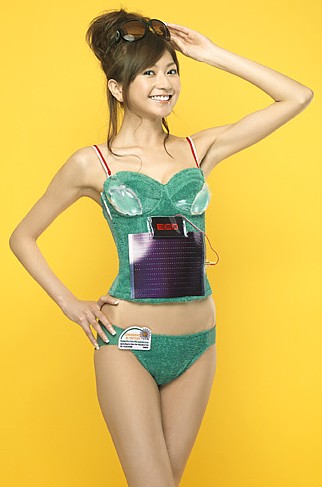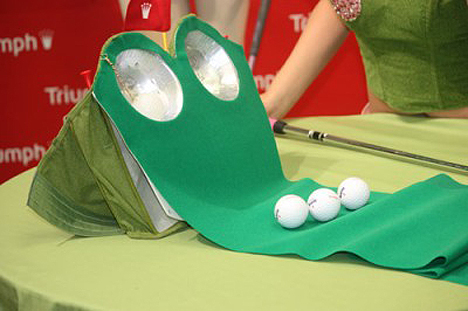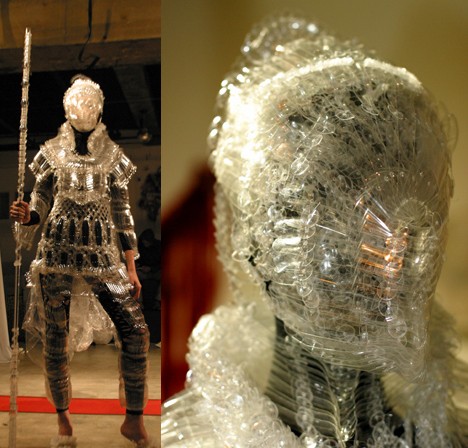Tuesday, November 24, 2009
Multi-productivity
From the makers of the Nice Cup in Bra dual-use-putting-mat-and-brassiere, comes (and I can't believe I missed this the first time) the Solar Powered Bra!
TOTALLY not useful. The front-mounted solar panel powers a small billboard which proclaims eco-conscious messages or another user-defined electronic item. The small augmentation pouches are actually consumable Camelpak-style water vessels which "reduce aluminum and plastic waste while enhancing your bust size."
Once again, the answer to "How?" without thought of the question "Why" - still it's hilarious.
Powered by Salt
Science...
I had to look up what "brackish water" was and how this would "add pressure" - brackish water has more salinity than fresh water but not as much as salt water.
Here's the basic concept of osmosis and how it is converted into usable energy:
"When freshwater and seawater meet on either side of a membrane -- a thin layer that retains salt but lets water pass -- freshwater is drawn towards the seawater side. The flow puts pressure on the seawater side, and that pressure can be used to drive a turbine, producing electricity."
I guess the brackish water adds a kick at the end of the process without really slowing it down at it's final destination in the osmotic energy process.
Pretty neat.
What is Justice? My philosophical ramblings...
Excerpts from Wikipedia:
Concept of Justice
Justice concerns itself with the proper ordering of things and persons within a society. As a concept it has been subject to philosophical, legal, and theological reflection and debate throughout our history. A number of important questions surrounding justice have been fiercely debated over the course of western history: What is justice? What does it demand of individuals and societies? What is the proper distribution of wealth and resources in society: equal, meritocratic, according to status, or some other arrangement? There are myriad possible answers to these questions from divergent perspectives on the political and philosophical spectrum.
Studies at Western Kentucky University in 2008 have indicated that reactions to fairness are "wired" into the brain and that, "Fairness is activating the same part of the brain that responds to food in rats... This is consistent with the notion that being treated fairly satisfies a basic need" [5]. Research conducted in 2003 at Emory University, Georgia, involving Capuchin Monkeys demonstrated that other cooperative animals also possess such a sense and that "inequality aversion may not be uniquely human."[6] indicating that ideas of fairness and justice may be instinctual in nature.
This semester I've read from authors with a wide range of perspectives and agendas. I think, for me it all hinged on Adrian Piper's "Ideology, Confrontation, and Political Self.Awareness: An Essay"
General concepts of "justice" indicate the human capacity or instinct to judge. While this is an important facet of humans as a species, when people forget that they are animals and don't pay respect to their own and others' individual instinctual needs for self-sustainability, we engage in the very behavior we preach to avoid. We assume we are right. Piper discusses many reasons why and how we justify arriving at this conclusion that we are right and someone else is wrong. I appreciated the fair and gentle accusations she made directly to (you) the reader. The presentation was perfect. We need not only judge ourselves as we judge others but judge the rule set we are judging from.
I conclude that justice and empathy are the same beast just as are humans and animals. We are too tied to everything and everyone to think there is one objective justice or truth.
Justice comes from within the self first, and then in empathy and relationship to others. Empathy is most productively made through the active and open engagement of ideas with others. Reception is not just listening but imagining, reaching for that which is inside oneself and opening that to another. It takes a lot of trust, something as animals we don't do easily. Empathy is a constantly evolving thing. When people get lazy, they stagnate and empathy is no longer possible.
Though justice will always be a complicated issue. I for one will continue on the basis of empathy - because that's really as far as I can get by myself. But it's far enough to have not stopped yet...
Concept of Justice
Justice concerns itself with the proper ordering of things and persons within a society. As a concept it has been subject to philosophical, legal, and theological reflection and debate throughout our history. A number of important questions surrounding justice have been fiercely debated over the course of western history: What is justice? What does it demand of individuals and societies? What is the proper distribution of wealth and resources in society: equal, meritocratic, according to status, or some other arrangement? There are myriad possible answers to these questions from divergent perspectives on the political and philosophical spectrum.
Studies at Western Kentucky University in 2008 have indicated that reactions to fairness are "wired" into the brain and that, "Fairness is activating the same part of the brain that responds to food in rats... This is consistent with the notion that being treated fairly satisfies a basic need" [5]. Research conducted in 2003 at Emory University, Georgia, involving Capuchin Monkeys demonstrated that other cooperative animals also possess such a sense and that "inequality aversion may not be uniquely human."[6] indicating that ideas of fairness and justice may be instinctual in nature.
This semester I've read from authors with a wide range of perspectives and agendas. I think, for me it all hinged on Adrian Piper's "Ideology, Confrontation, and Political Self.Awareness: An Essay"
General concepts of "justice" indicate the human capacity or instinct to judge. While this is an important facet of humans as a species, when people forget that they are animals and don't pay respect to their own and others' individual instinctual needs for self-sustainability, we engage in the very behavior we preach to avoid. We assume we are right. Piper discusses many reasons why and how we justify arriving at this conclusion that we are right and someone else is wrong. I appreciated the fair and gentle accusations she made directly to (you) the reader. The presentation was perfect. We need not only judge ourselves as we judge others but judge the rule set we are judging from.
I conclude that justice and empathy are the same beast just as are humans and animals. We are too tied to everything and everyone to think there is one objective justice or truth.
Justice comes from within the self first, and then in empathy and relationship to others. Empathy is most productively made through the active and open engagement of ideas with others. Reception is not just listening but imagining, reaching for that which is inside oneself and opening that to another. It takes a lot of trust, something as animals we don't do easily. Empathy is a constantly evolving thing. When people get lazy, they stagnate and empathy is no longer possible.
Though justice will always be a complicated issue. I for one will continue on the basis of empathy - because that's really as far as I can get by myself. But it's far enough to have not stopped yet...
Tuesday, November 17, 2009
Double Productive
Since I am a (while probably untraditionally, so) feminist, this should probably be highly offensive to me, but quite to the contrary, I think it's awesome.
I don't really know if double (or even triple) use items justify something sustainable. Are they more efficient? Are they indicative of what our consumerist culture thinks it "needs?" Are products like this breeding more problems? I don't know. Alls I know is this is hilarious.
I don't really know if double (or even triple) use items justify something sustainable. Are they more efficient? Are they indicative of what our consumerist culture thinks it "needs?" Are products like this breeding more problems? I don't know. Alls I know is this is hilarious.
GAh, they stole my idea: What can I do with these pesky water bottles - Episode 2
A Very Similar Idea
For my recycled art project I wanted to make a "Water Warrior" costume - a combination of 16th Century Samurai Sensability with Present-day Petroleum Products. But it seems this designer has already executed a similar idea in high fashion - I'm still gonna do it though, you watch me.
What can I do with those pesky water bottles?
And another from Inhabitat.
And another from Inhabitat. Coming soon, episode 2 of "What can I do with these pesky water bottles?"
Broken Glass
I find myself washing dishes when I get really upset. I had just discovered some new information concerning a member of my immediate family. Gently as ever, when I slid the freshly washed glass onto another in my cabinet, it broke in my hand. The sight of the set of 4 glasses (previously 8 in the last decade) reduced by one more, leaving only 3 made me burst into tears. I've been chastised or eye-rolled in the past for my childish personification of material objects. I guess I see where when the item is stripped of it's purpose, it's labor, it is thrown away. Pretty Marxist sentiment here, I know. I recall a time when I was 22 and working my ass off in the heat of my first summer stock theatre program. 5'2" and female, I found I was the heartiest and most dedicated worker of our 4-student crew. The pay was barely enough to live on and the work was grueling - typical for stage work. We had just had a meeting where the higher ups told us that we needed to buy our own insurance (because one girl had just cut a major portion of her finger off with a portable grinder) and I was helping the others carry some steal frames on a dolly, when in a moment we had to negotiate the steel through a small door, I had just turned down a suggestion to ram the lot over a sizable threshhold. They did it anyway and where I was standing there was no choice but for me to catch the whole stack before it fell on my toes. I threw my back out for the first time (and many times subsequently in it's weakened state) and my boss (a young male professor) has the audacity as I limped away, sciatic nerve pinched in my spine, to say "This is Kentucky, Lexi. We put down a horse with a limp."
I know I'm breaking down, like a glass, a fruit, a horse. And surely this is why people make plastics. These
plastic jars are no solution to my death fear, but they are recyclable. And they never shatter.
"Collateral"
This New Zealand artist won a $15,000 competition for calling up the gallery staff and having them collect and pile the packaging refuse of the other contestants and label it "Collateral." Based in Berlin, he also never wasted any gas, dirtying up our atmosphere getting to the event, because he never left his home.
Zany.
Tuesday, November 3, 2009
Health Hazard of the Future?
Hold on to your childhood... there are varying accounts on the safety of your favorite 80s science snack. This facebook character argues that there is mercury and other dangerous elements in Dippin' Dots, the "futuristic" ice cream company based in Paducah, KY. The science of these ice cream "dots" lie in the process by which the creamy goodness is sprayed into liquid nitrogen which "flsh freezes" the particles into tiny beads.
This cult classic has a following of weirdos who also want to flash freeze ice cream. Here is the documentation of those odd characters' questions and answers.
Honestly I was not able to back this guys claim about the mercury and I did a lot of searching. While money-making companies are not the most unbiased sources of information, this is what Dippin' Dots themselves have to say about their process.
P.S. Dippin Dots are made in Seoul, Korea.
Sustainability for Sale
Your chance is here to own a relatively new environmentally friendly vehichle. My friend Nisha is moving to Denver Colorado and unloading her new bicycle with personal additions including a basket and helmet for a reasonable cost.
You can contact her about joining the revolution at the above number or on her
facebook ad.
Monday, November 2, 2009
Recycling Carboard
Some recycling problems:
Here are some things I wanted to recycle - small cardboard teabag boxes. However they are coated with a waxy surface that renders them out of bounds for local recycling pick up. I understand they are useful to keep freezer moisture out of the interior of the box, but my question is: If there is a plastic bag inside the box, why the extra layer of waxy coating? Couldn't at least part of this packaging be recyclable? In the case of the teas, it makes sense that you don't want moisture going into your teabags, and this particular tea company does not package their teabags in a plastic bag - they are wrapped in paper. However, I have since discovered other companies who package their tea in non-waxy boxes... though there is more packaging inside the box. Here is more information from Santa Clara University's Sustainability Q&A site.
Subscribe to:
Posts (Atom)












